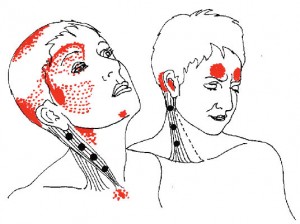Part three – Myofascial Trigger Points
Trigger Points, also known as Myofascial Trigger Points (MTP’s), are areas of extreme tension in soft tissue. They are often referred to as ‘knots’ but this isn’t quite correct as although both form in soft tissue and can have the same cause MTP’s cause referred pain whereas knots do not necessarily. Trigger Points have been well mapped within muscular tissue due primarily to the work of Dr. Janet Travell, White House Physician to President John F. Kennedy.
Trigger Points can be very painful and will undoubtedly restrict and confine range of movement. To give you an example of how Trigger Points manifest; tension in the muscles of the neck from working at a computer can lead to tension headaches. This is due to the continual contraction of the muscles during the working day causing them to remain in a contracted state bringing the positive activity of Trigger Points referring pain into the head.
What causes the build up of Trigger Points?
• Overload
• Overuse
• Constant activity
• Long term inactivity
• Arthritis
• Fibromyalgia
*This list provides only a few examples but is not exhaustive.
Symptoms of active Trigger Points
• Pain
• Reduced range of movement
• Hypertonic muscle tissue
• Resistance to more usual methods such as heat, stretching
• Increased muscle tone in surrounding area
• Reduced blood and lymph flow
• Presence of inflammatory markers
Once the therapist has established the presence of MTP’s and used Myofascial Release to stretch out restricted fascia they will begin to work on relieving the hypertonic points in the tissues. These points are known to be hyper-irritable and can cause pain when compressed. The therapist needs to work with the client to ensure treatment is as comfortable as possible whilst still being effective to release the tension.

There is little scientific research to back up claims about Trigger Points but whatever name we give to them and call our therapeutic interventions, massage therapy helps to relieve tight muscle tissue and restore normal function.
Trigger Points are common amongst those who have sedentary jobs as the postural muscles are constantly contracted throughout the working day. They are also common in athletes due to the repetitive nature of training.
“If athletes knew about the effects of myofascial trigger points and took the time to do the appropriate self-treatment, there would be many fewer sports injuries”.
Clair Davies (1)
References
(1) Davies, C. And Davies, A. 2013. The Trigger Point Therapy Workbook. Third edition. Oakland CA: New Harbinger Publications Inc.